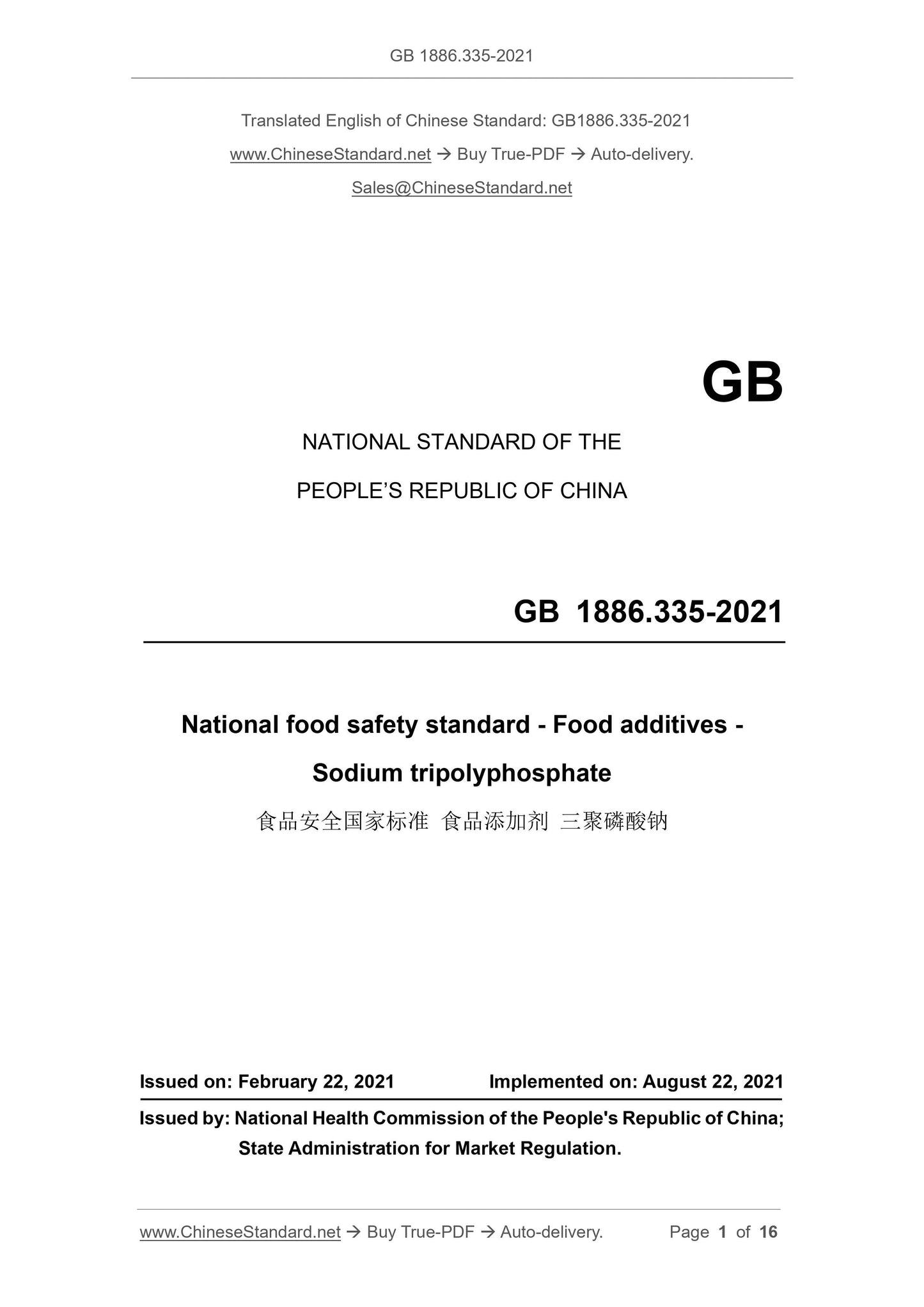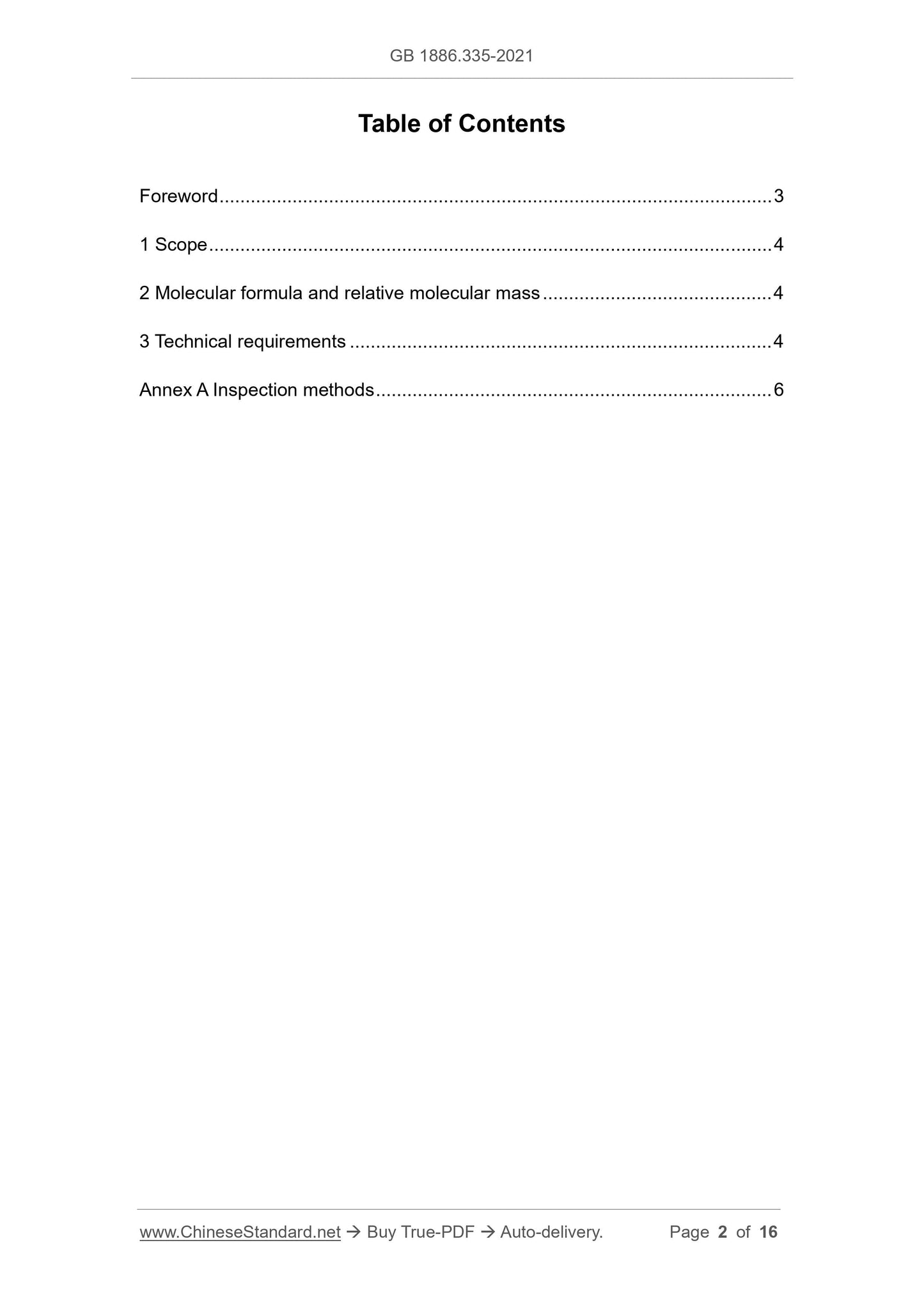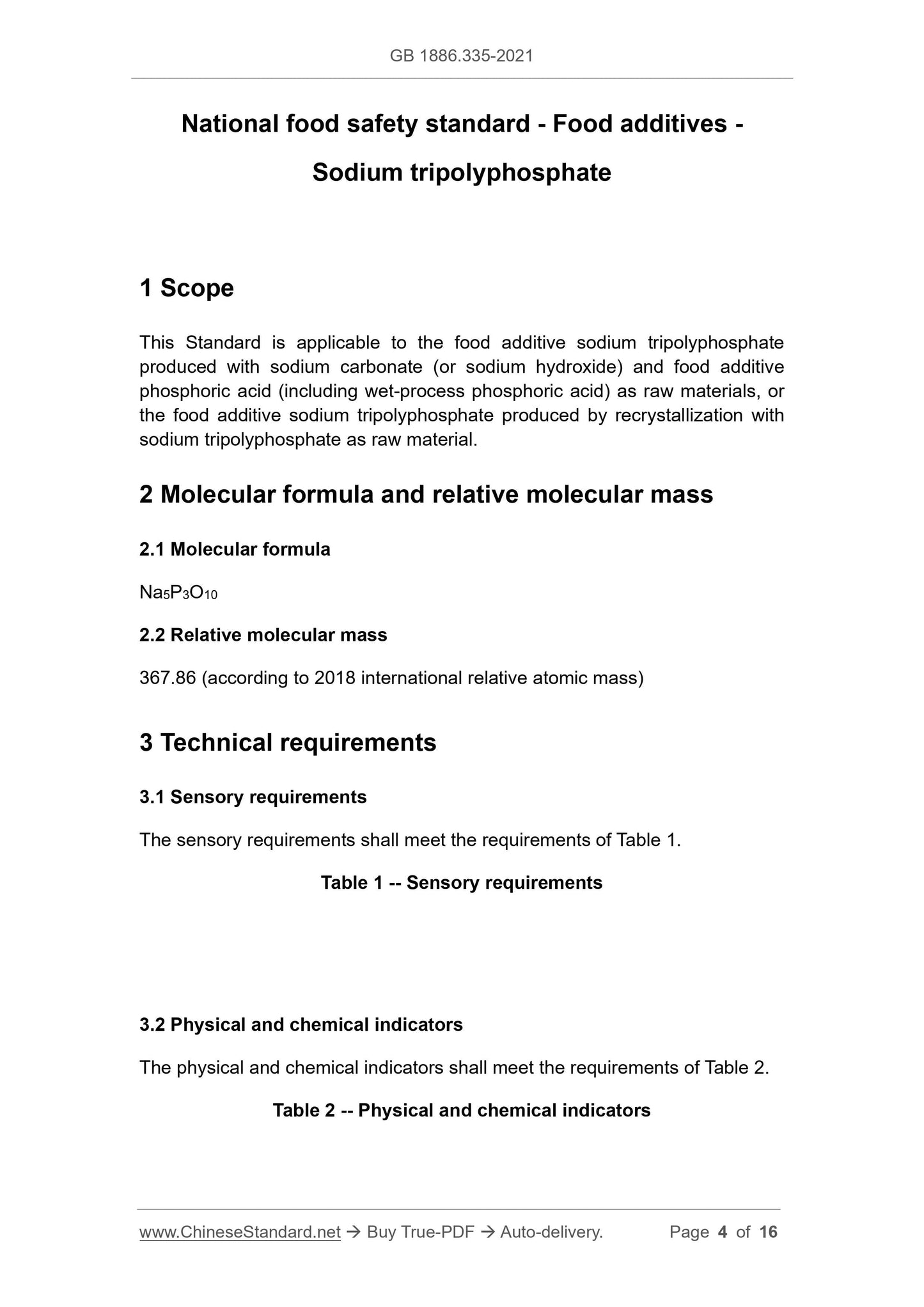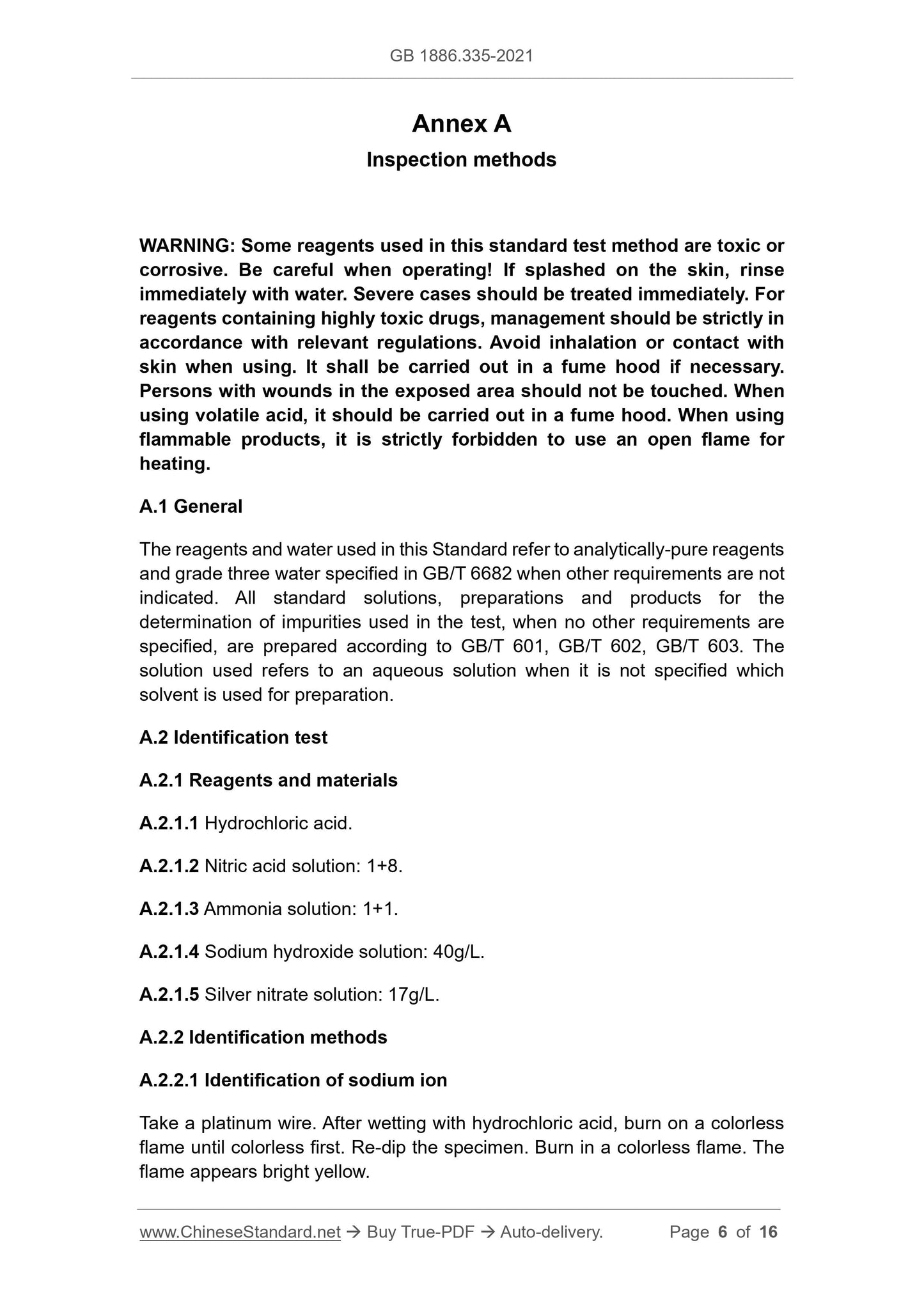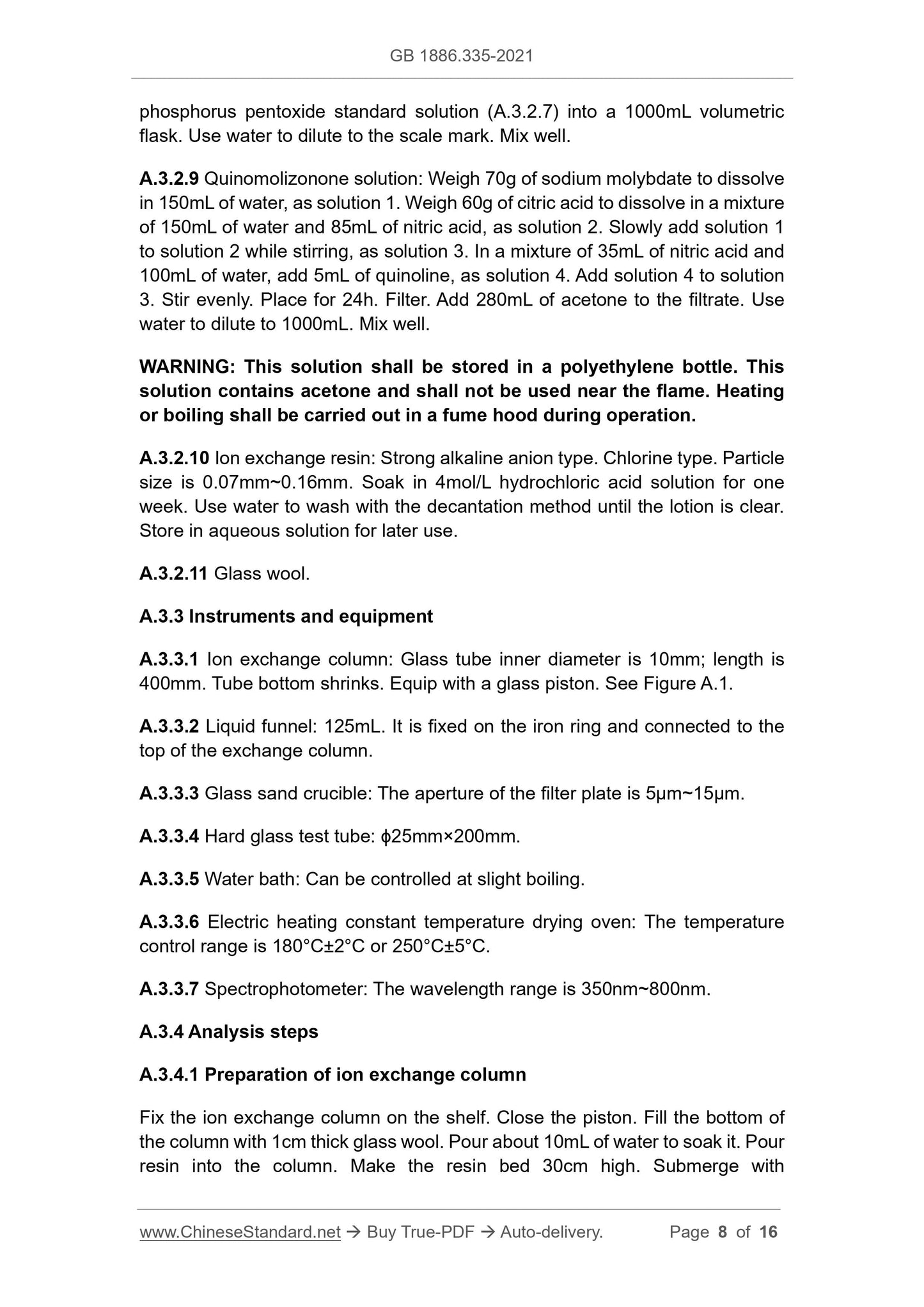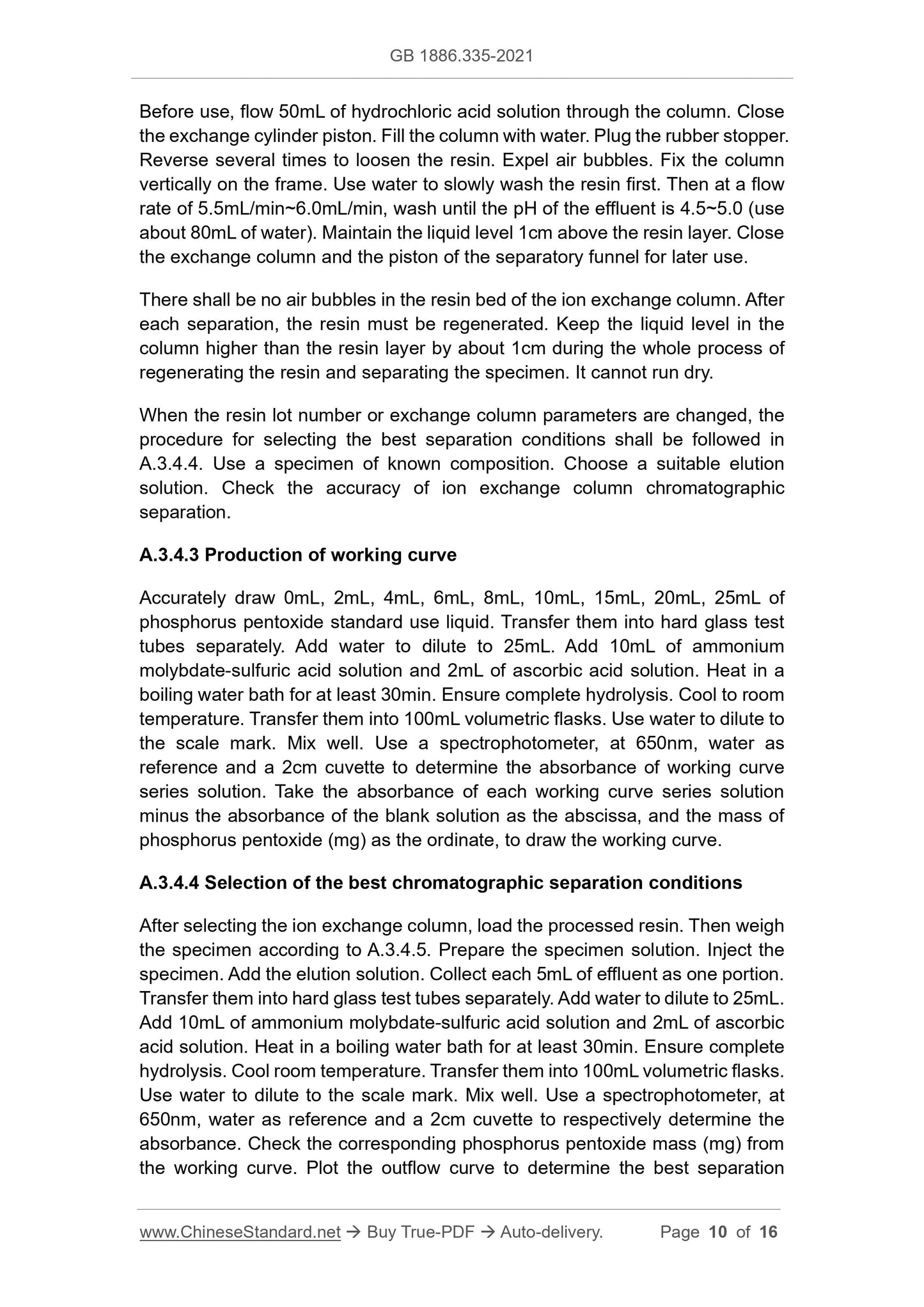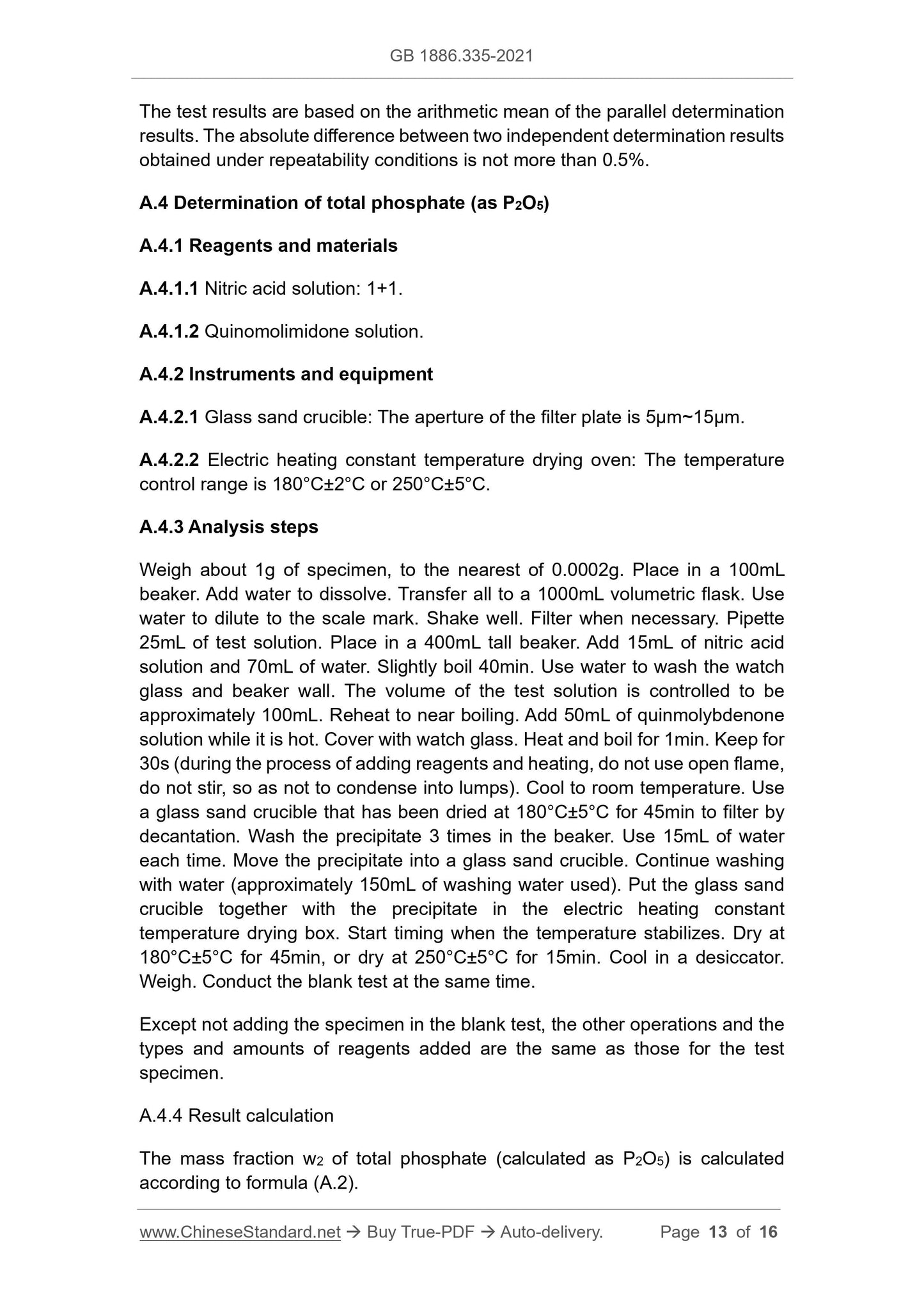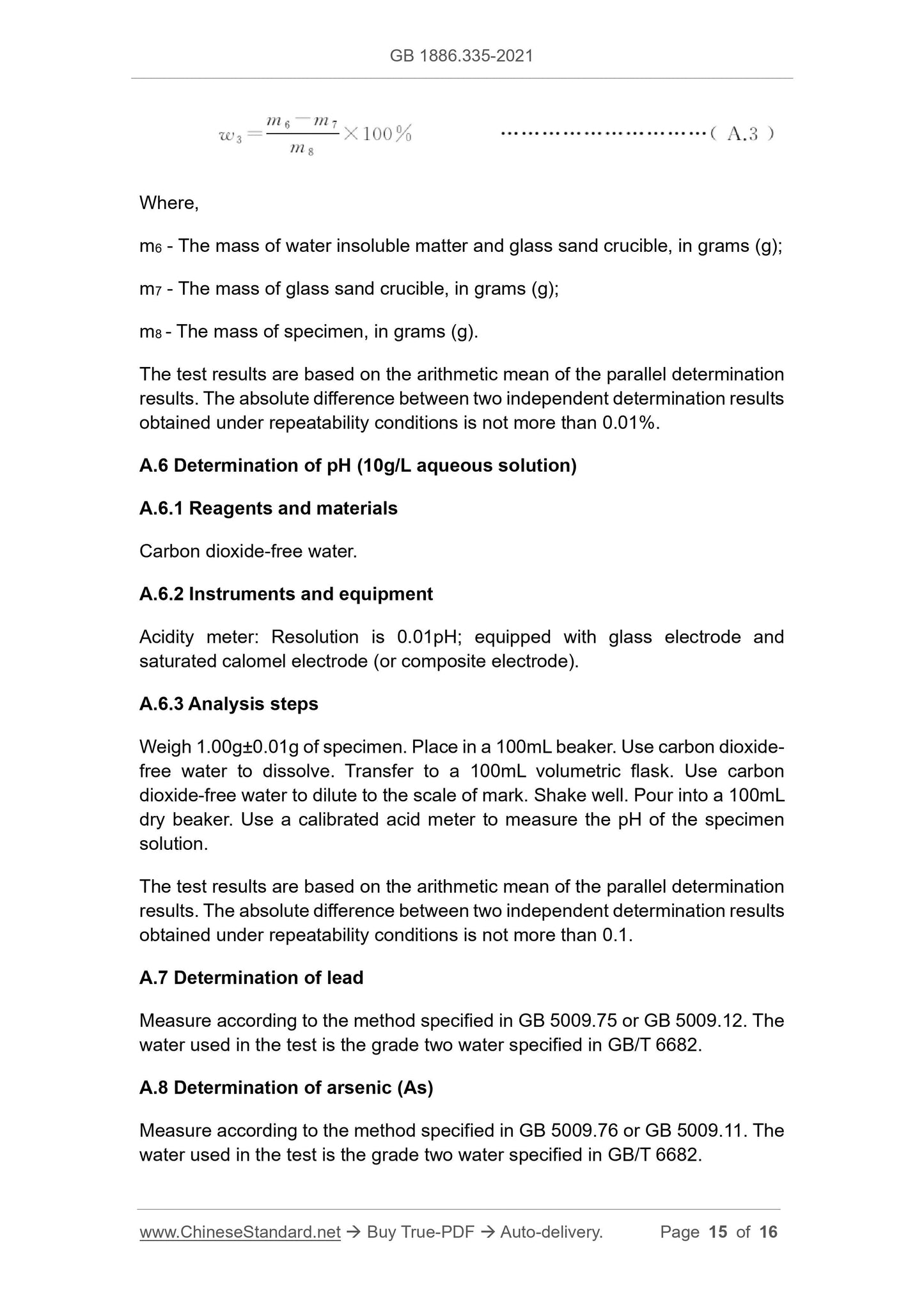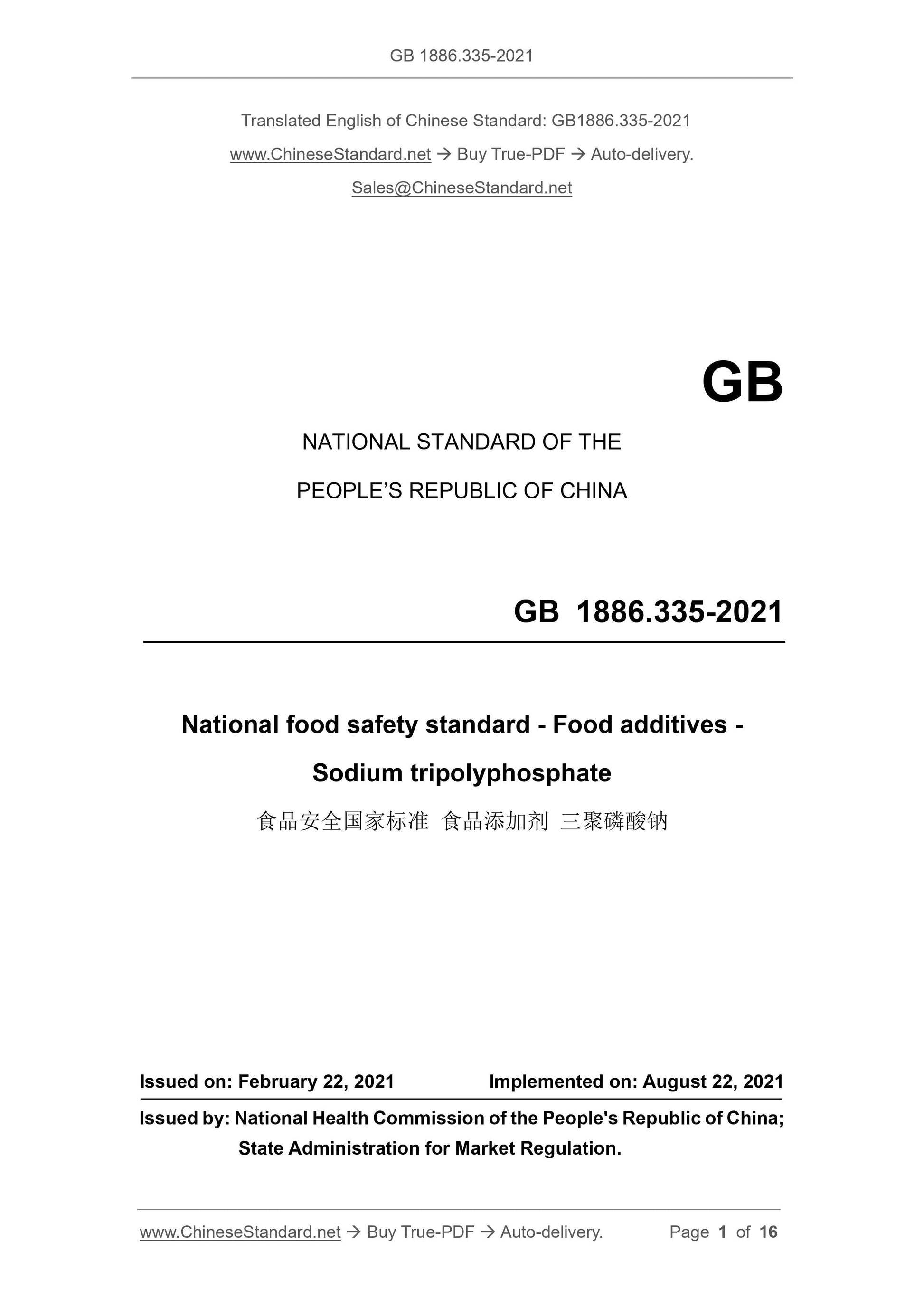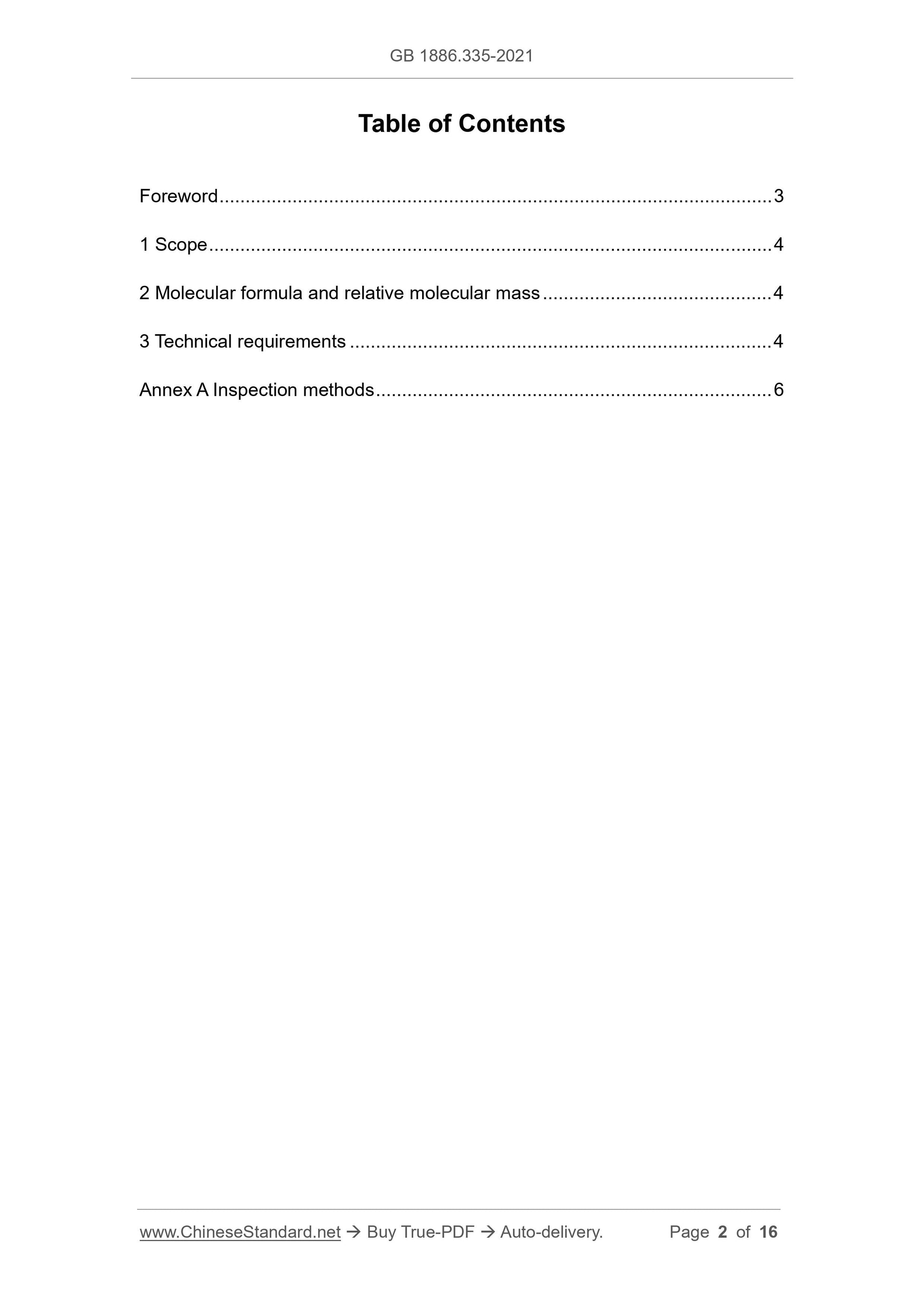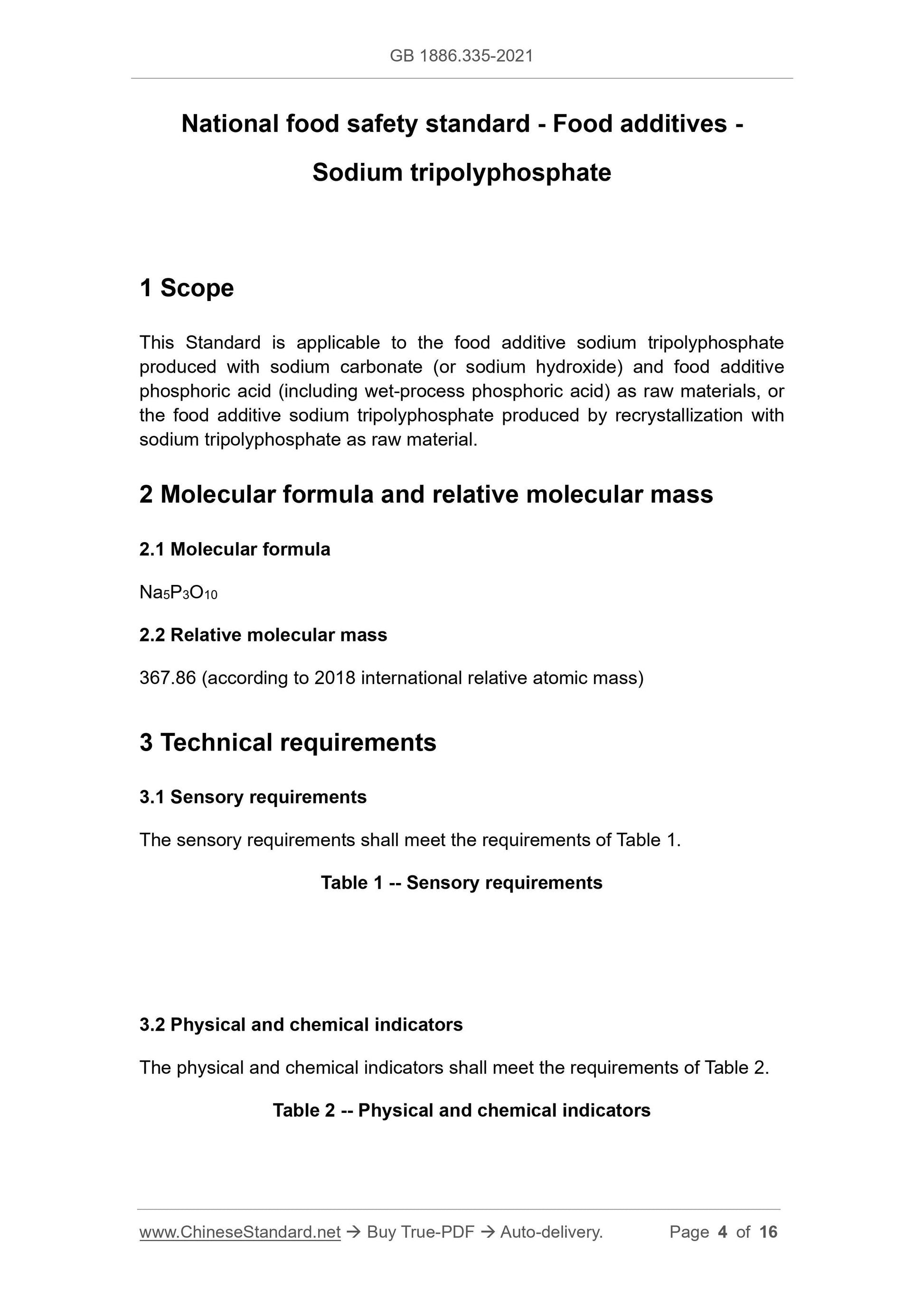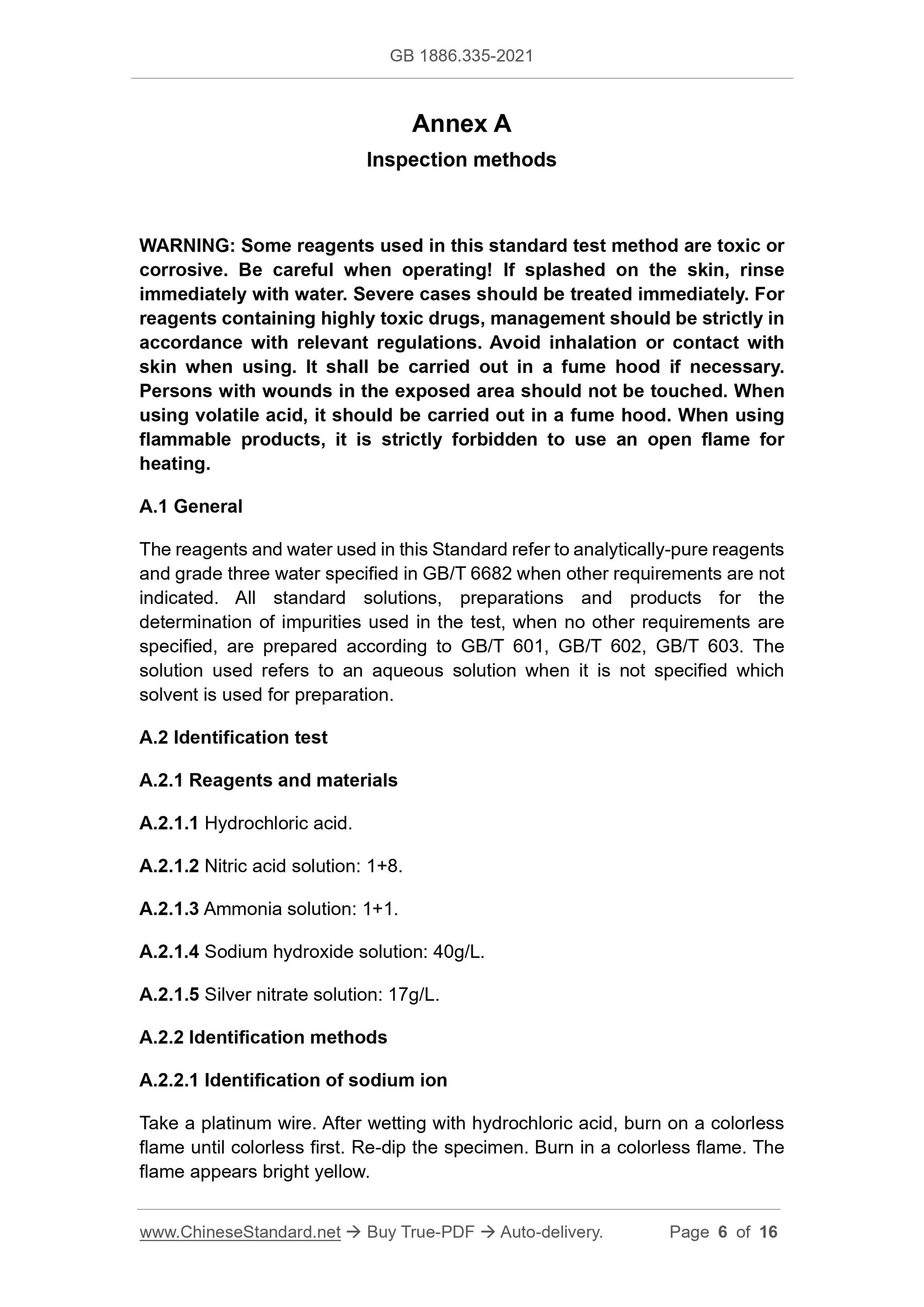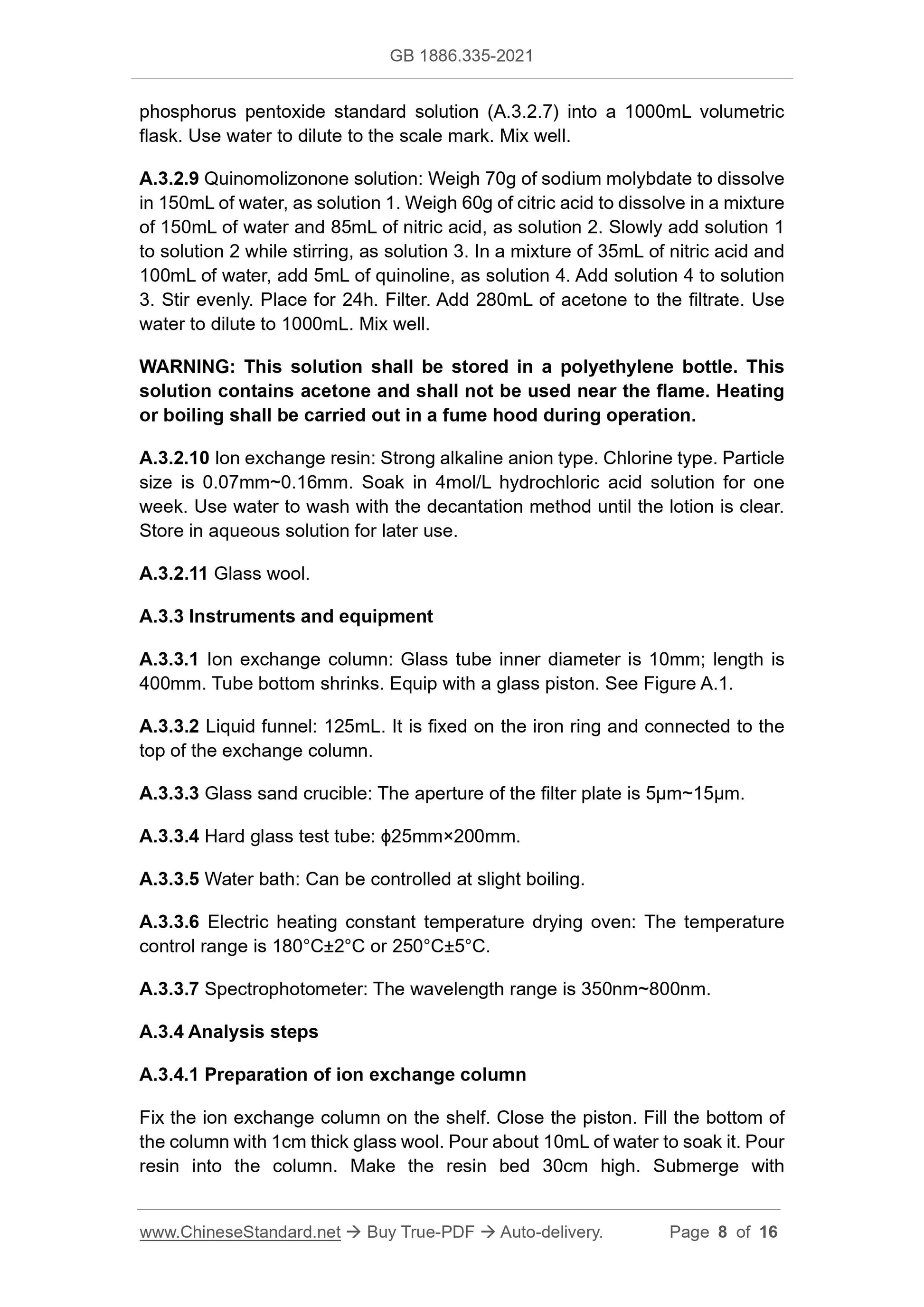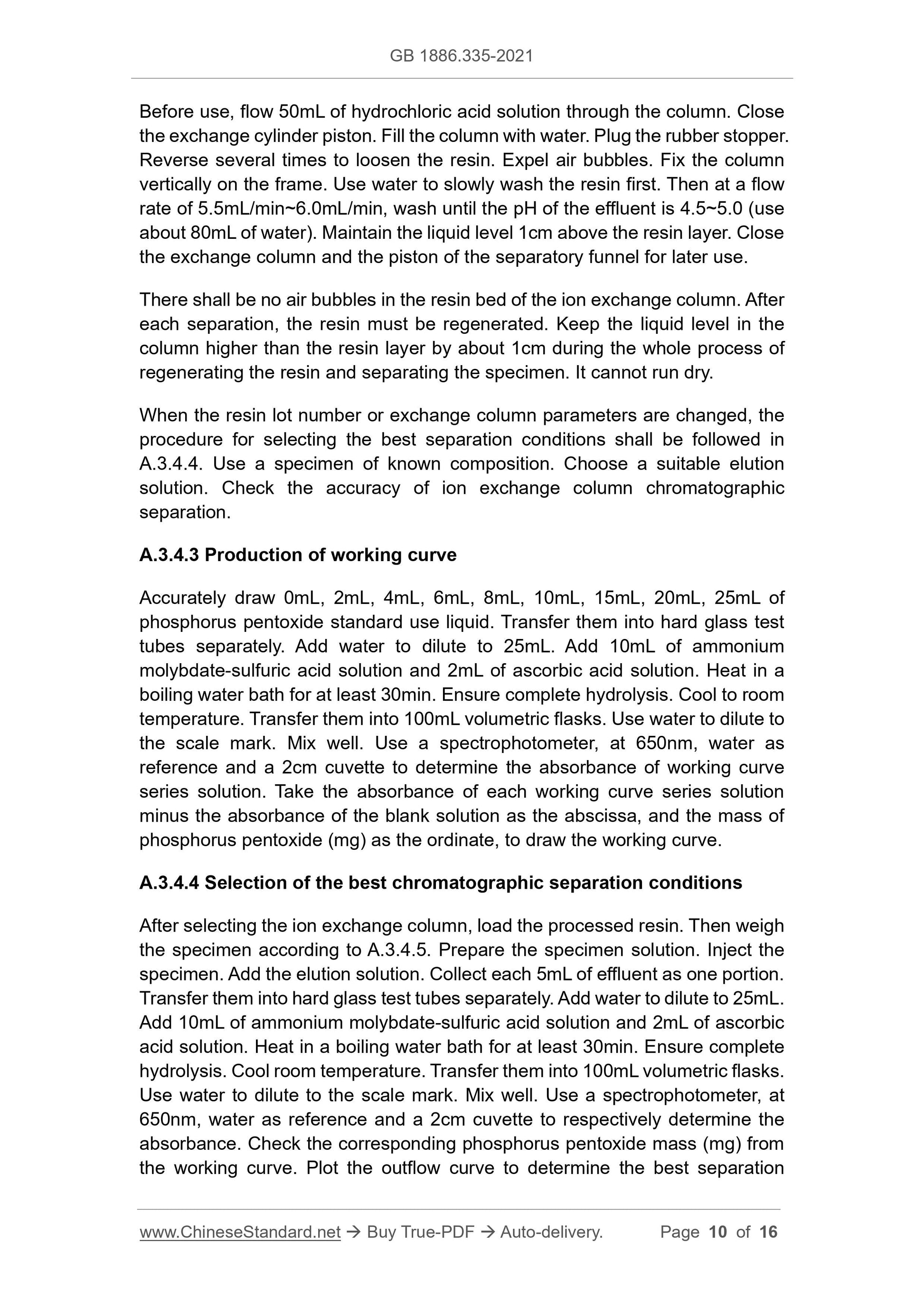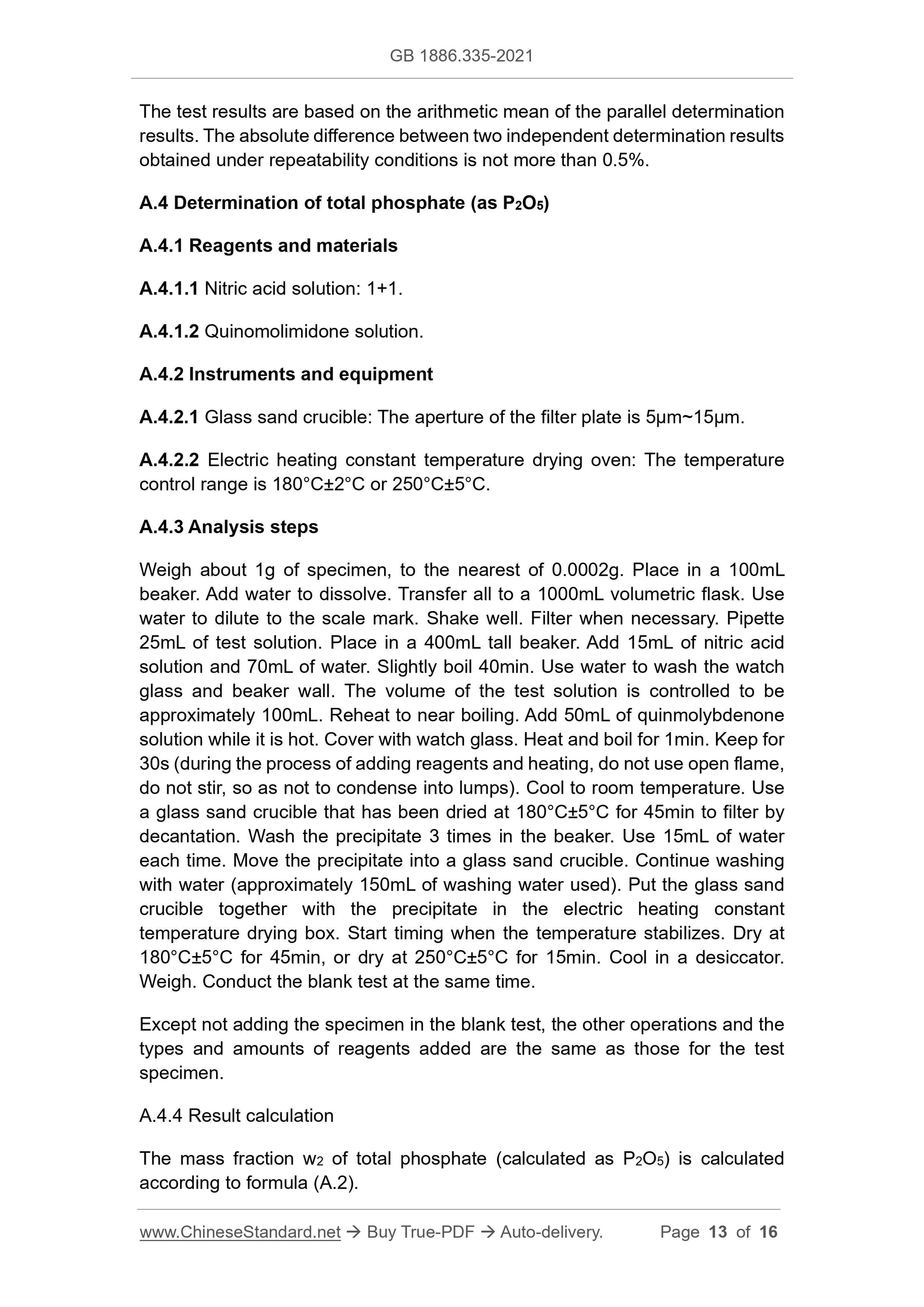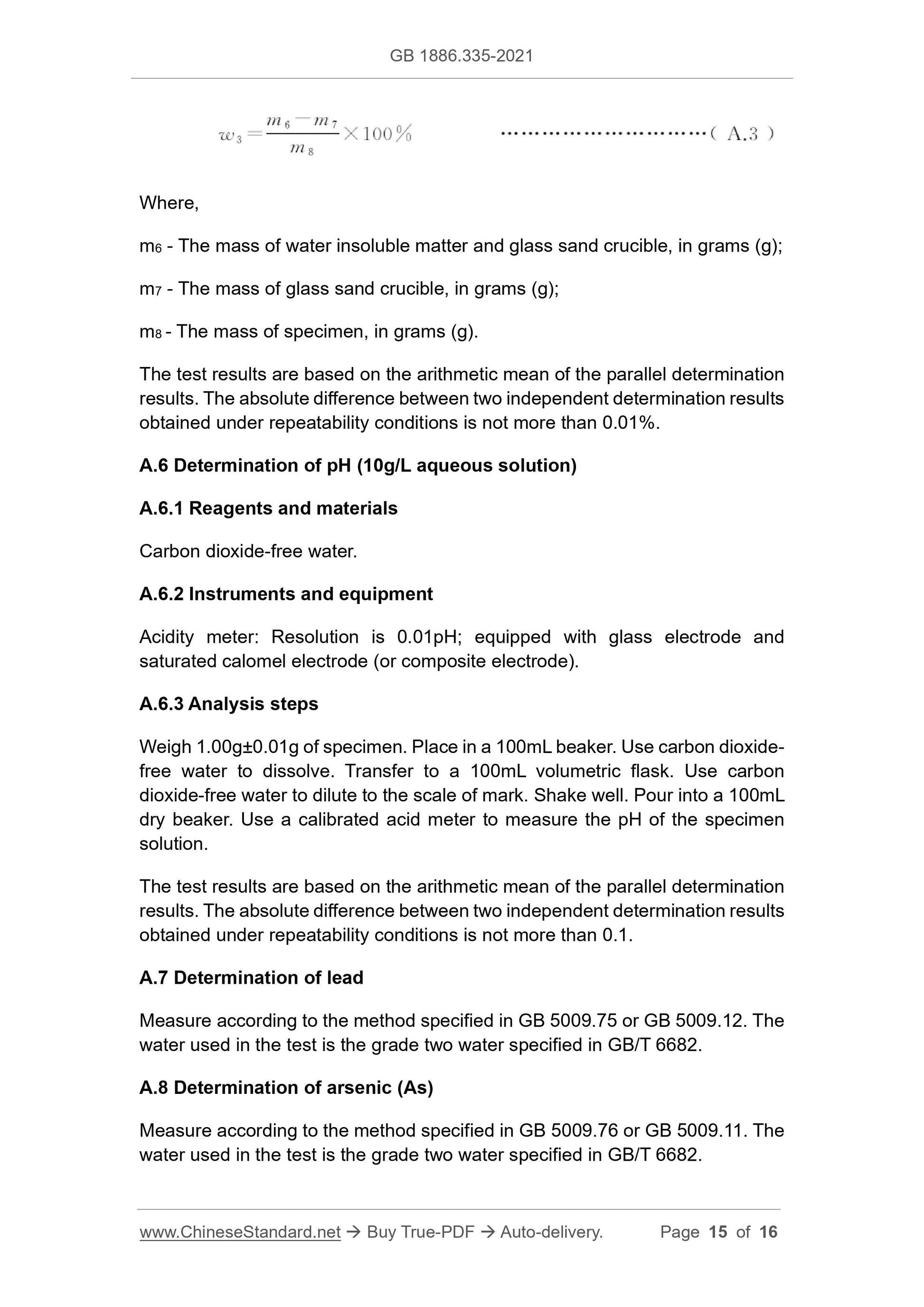1
/
of
8
PayPal, credit cards. Download editable-PDF & invoice in 1 second!
GB 1886.335-2021 English PDF (GB1886.335-2021)
GB 1886.335-2021 English PDF (GB1886.335-2021)
Regular price
$170.00 USD
Regular price
Sale price
$170.00 USD
Unit price
/
per
Shipping calculated at checkout.
Couldn't load pickup availability
Delivery: 3 seconds. Download true-PDF + Invoice.
Get QUOTATION in 1-minute: Click GB 1886.335-2021
Historical versions: GB 1886.335-2021
Preview True-PDF (Reload/Scroll if blank)
GB 1886.335-2021: National food safety standard - Food additives - Sodium tripolyphosphate
GB 1886.335-2021
GB
NATIONAL STANDARD OF THE
PEOPLE’S REPUBLIC OF CHINA
National food safety standard - Food additives -
Sodium tripolyphosphate
ISSUED ON: FEBRUARY 22, 2021
IMPLEMENTED ON: AUGUST 22, 2021
Issued by: National Health Commission of the People's Republic of China;
State Administration for Market Regulation.
Table of Contents
Foreword ... 3
1 Scope ... 4
2 Molecular formula and relative molecular mass ... 4
3 Technical requirements ... 4
Annex A Inspection methods ... 6
National food safety standard - Food additives -
Sodium tripolyphosphate
1 Scope
This Standard is applicable to the food additive sodium tripolyphosphate
produced with sodium carbonate (or sodium hydroxide) and food additive
phosphoric acid (including wet-process phosphoric acid) as raw materials, or
the food additive sodium tripolyphosphate produced by recrystallization with
sodium tripolyphosphate as raw material.
2 Molecular formula and relative molecular mass
2.1 Molecular formula
Na5P3O10
2.2 Relative molecular mass
367.86 (according to 2018 international relative atomic mass)
3 Technical requirements
3.1 Sensory requirements
The sensory requirements shall meet the requirements of Table 1.
Table 1 -- Sensory requirements
3.2 Physical and chemical indicators
The physical and chemical indicators shall meet the requirements of Table 2.
Table 2 -- Physical and chemical indicators
Annex A
Inspection methods
WARNING: Some reagents used in this standard test method are toxic or
corrosive. Be careful when operating! If splashed on the skin, rinse
immediately with water. Severe cases should be treated immediately. For
reagents containing highly toxic drugs, management should be strictly in
accordance with relevant regulations. Avoid inhalation or contact with
skin when using. It shall be carried out in a fume hood if necessary.
Persons with wounds in the exposed area should not be touched. When
using volatile acid, it should be carried out in a fume hood. When using
flammable products, it is strictly forbidden to use an open flame for
heating.
A.1 General
The reagents and water used in this Standard refer to analytically-pure reagents
and grade three water specified in GB/T 6682 when other requirements are not
indicated. All standard solutions, preparations and products for the
determination of impurities used in the test, when no other requirements are
specified, are prepared according to GB/T 601, GB/T 602, GB/T 603. The
solution used refers to an aqueous solution when it is not specified which
solvent is used for preparation.
A.2 Identification test
A.2.1 Reagents and materials
A.2.1.1 Hydrochloric acid.
A.2.1.2 Nitric acid solution: 1+8.
A.2.1.3 Ammonia solution: 1+1.
A.2.1.4 Sodium hydroxide solution: 40g/L.
A.2.1.5 Silver nitrate solution: 17g/L.
A.2.2 Identification methods
A.2.2.1 Identification of sodium ion
Take a platinum wire. After wetting with hydrochloric acid, burn on a colorless
flame until colorless first. Re-dip the specimen. Burn in a colorless flame. The
flame appears bright yellow.
phosphorus pentoxide standard solution (A.3.2.7) into a 1000mL volumetric
flask. Use water to dilute to the scale mark. Mix well.
A.3.2.9 Quinomolizonone solution: Weigh 70g of sodium molybdate to dissolve
in 150mL of water, as solution 1. Weigh 60g of citric acid to dissolve in a mixture
of 150mL of water and 85mL of nitric acid, as solution 2. Slowly add solution 1
to solution 2 while stirring, as solution 3. In a mixture of 35mL of nitric acid and
100mL of water, add 5mL of quinoline, as solution 4. Add solution 4 to solution
3. Stir evenly. Place for 24h. Filter. Add 280mL of acetone to the filtrate. Use
water to dilute to 1000mL. Mix well.
WARNING: This solution shall be stored in a polyethylene bottle. This
solution contains acetone and shall not be used near the flame. Heating
or boiling shall be carried out in a fume hood during operation.
A.3.2.10 Ion exchange resin: Strong alkaline anion type. Chlorine type. Particle
size is 0.07mm~0.16mm. Soak in 4mol/L hydrochloric acid solution for one
week. Use water to wash with the decantation method until the lotion is clear.
Store in aqueous solution for later use.
A.3.2.11 Glass wool.
A.3.3 Instruments and equipment
A.3.3.1 Ion exchange column: Glass tube inner diameter is 10mm; length is
400mm. Tube bottom shrinks. Equip with a glass piston. See Figure A.1.
A.3.3.2 Liquid funnel: 125mL. It is fixed on the iron ring and connected to the
top of the exchange column.
A.3.3.3 Glass sand crucible: The aperture of the filter plate is 5μm~15μm.
A.3.3.4 Hard glass test tube: ϕ25mm×200mm.
A.3.3.5 Water bath: Can be controlled at slight boiling.
A.3.3.6 Electric heating constant temperature drying oven: The temperature
control range is 180°C±2°C or 250°C±5°C.
A.3.3.7 Spectrophotometer: The wavelength range is 350nm~800nm.
A.3.4 Analysis steps
A.3.4.1 Preparation of ion exchange column
Fix the ion exchange column on the shelf. Close the piston. Fill the bottom of
the column with 1cm thick glass wool. Pour about 10mL of water to soak it. Pour
resin into the column. Make the resin bed 30cm high. Submerge with
Before use, flow 50mL of hydrochloric acid solution through the column. Close
the exchange cylinder piston. Fill the column with water. Plug the rubber stopper.
Reverse several times to loosen the resin. Expel air bubbles. Fix the column
vertically on the frame. Use water to slowly wash the resin first. Then at a flow
rate of 5.5mL/min~6.0mL/min, wash until the pH of the effluent is 4.5~5.0 (use
about 80mL of water). Maintain the liquid level 1cm above the resin layer. Close
the exchange column and the piston of the separatory funnel for later use.
There shall be no air bubbles in the resin bed of the ion exchange column. After
each separation, the resin must be regenerated. Keep the liquid level in the
column higher than the resin layer by about 1cm during the whole process of
regenerating the resin and separating the specimen. It cannot run dry.
When the resin lot number or exchange column parameters are changed, the
procedure for selecting the best separation conditions shall be followed in
A.3.4.4. Use a specimen of known composition. Choose a suitable elution
solution. Check the accuracy of ion exchange column chromatographic
separation.
A.3.4.3 Production of working curve
Accurately draw 0mL, 2mL, 4mL, 6mL, 8mL, 10mL, 15mL, 20mL, 25mL of
phosphorus pentoxide standard use liquid. Transfer them into hard glass test
tubes separately. Add water to dilute to 25mL. Add 10mL of ammonium
molybdate-sulfuric acid solution and 2mL of ascorbic acid solution. Heat in a
boiling water bath for at least 30min. Ensure complete hydrolysis. Cool to room
temperature. Transfer them into 100mL volumetric flasks. Use water to dilute to
the scale mark. Mix well. Use a spectrophotometer, at 650nm, water as
reference and a 2cm cuvette to determine the absorbance of working curve
series solution. Take the absorbance of each working curve series solution
minus the absorbance of the blank solution as the abscissa, and the mass of
phosphorus pentoxide (mg) as the ordinate, to draw the working curve.
A.3.4.4 Selection of the best chromatographic separation conditions
After selecting the ion exchange column, load the processed resin. Then weigh
the specimen according to A.3.4.5. Prepare the specimen solution....
Get QUOTATION in 1-minute: Click GB 1886.335-2021
Historical versions: GB 1886.335-2021
Preview True-PDF (Reload/Scroll if blank)
GB 1886.335-2021: National food safety standard - Food additives - Sodium tripolyphosphate
GB 1886.335-2021
GB
NATIONAL STANDARD OF THE
PEOPLE’S REPUBLIC OF CHINA
National food safety standard - Food additives -
Sodium tripolyphosphate
ISSUED ON: FEBRUARY 22, 2021
IMPLEMENTED ON: AUGUST 22, 2021
Issued by: National Health Commission of the People's Republic of China;
State Administration for Market Regulation.
Table of Contents
Foreword ... 3
1 Scope ... 4
2 Molecular formula and relative molecular mass ... 4
3 Technical requirements ... 4
Annex A Inspection methods ... 6
National food safety standard - Food additives -
Sodium tripolyphosphate
1 Scope
This Standard is applicable to the food additive sodium tripolyphosphate
produced with sodium carbonate (or sodium hydroxide) and food additive
phosphoric acid (including wet-process phosphoric acid) as raw materials, or
the food additive sodium tripolyphosphate produced by recrystallization with
sodium tripolyphosphate as raw material.
2 Molecular formula and relative molecular mass
2.1 Molecular formula
Na5P3O10
2.2 Relative molecular mass
367.86 (according to 2018 international relative atomic mass)
3 Technical requirements
3.1 Sensory requirements
The sensory requirements shall meet the requirements of Table 1.
Table 1 -- Sensory requirements
3.2 Physical and chemical indicators
The physical and chemical indicators shall meet the requirements of Table 2.
Table 2 -- Physical and chemical indicators
Annex A
Inspection methods
WARNING: Some reagents used in this standard test method are toxic or
corrosive. Be careful when operating! If splashed on the skin, rinse
immediately with water. Severe cases should be treated immediately. For
reagents containing highly toxic drugs, management should be strictly in
accordance with relevant regulations. Avoid inhalation or contact with
skin when using. It shall be carried out in a fume hood if necessary.
Persons with wounds in the exposed area should not be touched. When
using volatile acid, it should be carried out in a fume hood. When using
flammable products, it is strictly forbidden to use an open flame for
heating.
A.1 General
The reagents and water used in this Standard refer to analytically-pure reagents
and grade three water specified in GB/T 6682 when other requirements are not
indicated. All standard solutions, preparations and products for the
determination of impurities used in the test, when no other requirements are
specified, are prepared according to GB/T 601, GB/T 602, GB/T 603. The
solution used refers to an aqueous solution when it is not specified which
solvent is used for preparation.
A.2 Identification test
A.2.1 Reagents and materials
A.2.1.1 Hydrochloric acid.
A.2.1.2 Nitric acid solution: 1+8.
A.2.1.3 Ammonia solution: 1+1.
A.2.1.4 Sodium hydroxide solution: 40g/L.
A.2.1.5 Silver nitrate solution: 17g/L.
A.2.2 Identification methods
A.2.2.1 Identification of sodium ion
Take a platinum wire. After wetting with hydrochloric acid, burn on a colorless
flame until colorless first. Re-dip the specimen. Burn in a colorless flame. The
flame appears bright yellow.
phosphorus pentoxide standard solution (A.3.2.7) into a 1000mL volumetric
flask. Use water to dilute to the scale mark. Mix well.
A.3.2.9 Quinomolizonone solution: Weigh 70g of sodium molybdate to dissolve
in 150mL of water, as solution 1. Weigh 60g of citric acid to dissolve in a mixture
of 150mL of water and 85mL of nitric acid, as solution 2. Slowly add solution 1
to solution 2 while stirring, as solution 3. In a mixture of 35mL of nitric acid and
100mL of water, add 5mL of quinoline, as solution 4. Add solution 4 to solution
3. Stir evenly. Place for 24h. Filter. Add 280mL of acetone to the filtrate. Use
water to dilute to 1000mL. Mix well.
WARNING: This solution shall be stored in a polyethylene bottle. This
solution contains acetone and shall not be used near the flame. Heating
or boiling shall be carried out in a fume hood during operation.
A.3.2.10 Ion exchange resin: Strong alkaline anion type. Chlorine type. Particle
size is 0.07mm~0.16mm. Soak in 4mol/L hydrochloric acid solution for one
week. Use water to wash with the decantation method until the lotion is clear.
Store in aqueous solution for later use.
A.3.2.11 Glass wool.
A.3.3 Instruments and equipment
A.3.3.1 Ion exchange column: Glass tube inner diameter is 10mm; length is
400mm. Tube bottom shrinks. Equip with a glass piston. See Figure A.1.
A.3.3.2 Liquid funnel: 125mL. It is fixed on the iron ring and connected to the
top of the exchange column.
A.3.3.3 Glass sand crucible: The aperture of the filter plate is 5μm~15μm.
A.3.3.4 Hard glass test tube: ϕ25mm×200mm.
A.3.3.5 Water bath: Can be controlled at slight boiling.
A.3.3.6 Electric heating constant temperature drying oven: The temperature
control range is 180°C±2°C or 250°C±5°C.
A.3.3.7 Spectrophotometer: The wavelength range is 350nm~800nm.
A.3.4 Analysis steps
A.3.4.1 Preparation of ion exchange column
Fix the ion exchange column on the shelf. Close the piston. Fill the bottom of
the column with 1cm thick glass wool. Pour about 10mL of water to soak it. Pour
resin into the column. Make the resin bed 30cm high. Submerge with
Before use, flow 50mL of hydrochloric acid solution through the column. Close
the exchange cylinder piston. Fill the column with water. Plug the rubber stopper.
Reverse several times to loosen the resin. Expel air bubbles. Fix the column
vertically on the frame. Use water to slowly wash the resin first. Then at a flow
rate of 5.5mL/min~6.0mL/min, wash until the pH of the effluent is 4.5~5.0 (use
about 80mL of water). Maintain the liquid level 1cm above the resin layer. Close
the exchange column and the piston of the separatory funnel for later use.
There shall be no air bubbles in the resin bed of the ion exchange column. After
each separation, the resin must be regenerated. Keep the liquid level in the
column higher than the resin layer by about 1cm during the whole process of
regenerating the resin and separating the specimen. It cannot run dry.
When the resin lot number or exchange column parameters are changed, the
procedure for selecting the best separation conditions shall be followed in
A.3.4.4. Use a specimen of known composition. Choose a suitable elution
solution. Check the accuracy of ion exchange column chromatographic
separation.
A.3.4.3 Production of working curve
Accurately draw 0mL, 2mL, 4mL, 6mL, 8mL, 10mL, 15mL, 20mL, 25mL of
phosphorus pentoxide standard use liquid. Transfer them into hard glass test
tubes separately. Add water to dilute to 25mL. Add 10mL of ammonium
molybdate-sulfuric acid solution and 2mL of ascorbic acid solution. Heat in a
boiling water bath for at least 30min. Ensure complete hydrolysis. Cool to room
temperature. Transfer them into 100mL volumetric flasks. Use water to dilute to
the scale mark. Mix well. Use a spectrophotometer, at 650nm, water as
reference and a 2cm cuvette to determine the absorbance of working curve
series solution. Take the absorbance of each working curve series solution
minus the absorbance of the blank solution as the abscissa, and the mass of
phosphorus pentoxide (mg) as the ordinate, to draw the working curve.
A.3.4.4 Selection of the best chromatographic separation conditions
After selecting the ion exchange column, load the processed resin. Then weigh
the specimen according to A.3.4.5. Prepare the specimen solution....
Share
